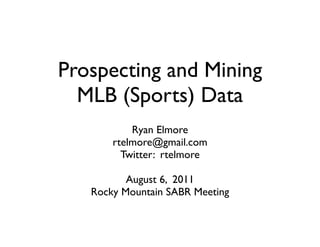Sabr
- 1. Prospecting and Mining MLB (Sports) Data Ryan Elmore rtelmore@gmail.com Twitter: rtelmore August 6, 2011 Rocky Mountain SABR Meeting
- 2. Data Science
- 3. ... And Hype The Economist May 14-20, 2011: ŌĆ£Corporate chefs are in demand again, of’¼üce rents are soaring and the pay being offered to talented folk in fashionable ’¼üelds like data science is reaching Hollywood levels.ŌĆØ
- 4. Not Your Typical Tech Talk
- 5. A Delayed Flight at DIA ...
- 6. Why Are The Games Boring?
- 7. Simmons Red Sox Data
- 8. Simmons Red Sox Data
- 9. A Few Thoughts ... ŌĆó The underlying data unit is in minutes. So? ŌĆó Why is he only looking at this particular set of year? ŌĆó How do the Red Sox compare to the other teams in MLB? ŌĆó Crap, that last point will require downloading a lot of data ... and my ’¼éight was boarding in 10 minutes!
- 10. Where Can We Get Data?
- 11. Where Can We Get Data? http://www.baseball-reference.com/teams/COL/2010-schedule-scores.shtml
- 12. Where Can We Get Data? http://www.baseball-reference.com/teams/COL/2010-schedule-scores.shtml Just step through all of the teams: COL, BOS, etc.
- 13. Where Can We Get Data? http://www.baseball-reference.com/teams/COL/2010-schedule-scores.shtml Just step through and any years all of the teams: that you are COL, BOS, etc. interested in.
- 14. A Typical Website The Golden Nugget
- 15. Data All Teams
- 17. Boston vs. The Rest
- 18. Are The Games Getting Longer? ŌĆó I donŌĆÖt know! ŌĆó I would say that the evidence supports an increase up until 2000 and then itŌĆÖs been constant or slightly decreasing. ŌĆó This is not an exercise in statistical inference; I was just mining the data and looking for trends. ŌĆó thelogcabin.wordpress.com/ ŌĆó github.com/rtelmore/MLB
- 19. Another Exercise ŌĆó In a conversation with Paul Parker, he asked if the minimum number of pitches per (full) inning (6 pitches) has ever been attained. ŌĆó This is a hard problem! ŌĆó Where do you ’¼ünd this sort of data? ŌĆó Back to baseball-reference.com ... the box scores. http://www.baseball-reference.com/boxes/COL/COL201104010.shtml
- 20. The Boxscore Website The Golden Nugget
- 21. How Do We Proceed? The most systematic way that I could ’¼ünd was to break it down like this: ŌĆó 30 Teams ŌĆó 2005 - 2010 ŌĆó Everyday from Apr 1 through Oct 31 ŌĆó This is a little more than 78K URLs! ŌĆó My program took about 3 hrs 25 min.
- 22. Was That Minimum Attained? ŌĆó NO! Unless there is an error in my code. ŌĆó Did we learn something? Of course. ŌĆó Example: I shouldŌĆÖve stored everything in a database while I was downloading and processing the data. Why? I didnŌĆÖt save any of the data from the 3+ hrs of computing. http://www.baseball-reference.com/boxes/COL/COL201104010.shtml
- 23. Using Google Trends Data ŌĆó http://www.google.com/trends ŌĆó You can put a search term in and it will return a lot of historical statistics related to your query (e.g., ’¼éu trends) ŌĆó There is an R package (RGoogleTrends) that allows access to the GT API if you have a google account (e.g., gmail). ŌĆó Use the getGTrends(ŌĆ£queryŌĆØ) function
- 25. GTrends ŌĆ£Colorado RockiesŌĆØ World Series Playoff Run
- 30. Conclusions/Discussion ŌĆó There is a lot of data available on the web! ŌĆó You can access this data from a browser; however, you can access A LOT more data if you let your computer do the work. ŌĆó Good tools for data mining: R, python, perl, etc. ŌĆó Download data and see where you go
- 31. Resources ŌĆó thelogcabin.wordpress.com ŌĆó github.com/rtelmore ŌĆó baseball-reference.com, espn.com, Google Trends, etc. ŌĆó Twitter (@rtelmore) ŌĆó www.r-project.org ŌĆó www.meetup.com/DenverRUG






























